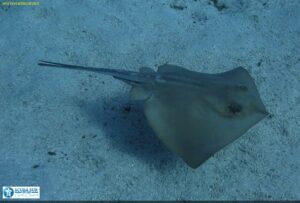The common stingray, the boss of the sea
The solitary common stingray can be scary when sighted. Some of the older animals are enormous and can appear out of nowhere. Definitely during night dives seeing them appear out of the dark, you better move away as they won’t!

- How to recognize a common stingray?
- Scuba Diving
- The common stingray diet
- Defense
- Good to know
- Some Science
- More Information
How to recognize a common stingray?
The common stingray has a body shaped more like a dice with pointy wings. It’s like its head is lying on top of its body. The plain grey coloration, the light belly and a mostly smooth skin are very recognizable. The tail is slender and whip-like, measuring approximately half as long as the disc.
A stinging spine with strong serrations, measuring up to 35 cm long and equipped with a venom gland at its base, is positioned about a third of the distance along the tail. A second or even third spine may also be present, as the spines are regularly replaced and new spines grow in before existing ones have been shed.
The common stingray is between 1.5 and 2.5m. At the highest point the height is 45 cm. Older individuals may also develop a row of bony knobs along the midline of the back.
Nice to know
The largest recorded common stingray specimen was found in 2016 in the Izmir province of Turkey in the course of a study on trolling. Its fins had a width of 2.21m, although its length could not be determined as the tail had been removed earlier.
Scuba Diving
The common stingray is typically found at depths accessible to recreational divers, but they can be spotted at depths down to 200m. It favours sandy or muddy bottoms in calm water but is also encountered near rocky reefs or in estuaries
Being a stingray, you better keep your distance. Although not aggressive, they will defend when feeling threatened and use their sting as a reflex. Remember, the sting of the common stingray is potentially dangerous.
The common stingray diet
This predator dwells the bottom to find crustaceans and fishes.
Defense
As part of the stingray family it will use its sting when being threatened.
The highest list if for fishermen accidently catching the stingray in their nets of on their hooks. when at the surface the stingray will be under complete stress and will use all the means possible into its defense.
Quite often we see species with their tail cut off. We expect that these species have been caught by fishermen who cut off their tail in order to be able to free the animal from the nets of hooks prior to releasing them.
Good to know
Scientists believe that stingrays have the ability to sense the polarity of the Earth’s magnetic field, an ability called magnetoreception. Stingrays may use this capability not only for hunting prey, but also for detecting the strength and angle of the Earth’s magnetic field and the orientation of electric currents generated by objects in the water. The stingray could then use that information to navigate in the open ocean.
Some Science
| Kingdom | Animalia |
| Phylum | Chordata |
| Class | Chondrichthyes |
| Order | Myliobatiformes |
| Family | Dasyatidae |
| Genus | Dasyatis |
| Species | Dasyatis pastinac |
More Information
We get many questions about what there is to see when you go diving in the south of Gran Canaria. We want to respond to this by creating a number of articles where each highlights a specific species we regularly encounter when diving in the Atlantic. The complete series gives you a good idea of what to find when scuba diving in the blue waters of the south of Gran Canaria. Let’s be clear we are not marine biologists; just a dive centre trying to provide valuable information to our customers.
For the full details of the species we would like to refer to www.Wikipedia.com. Here you’ll find more detail than we go into.



